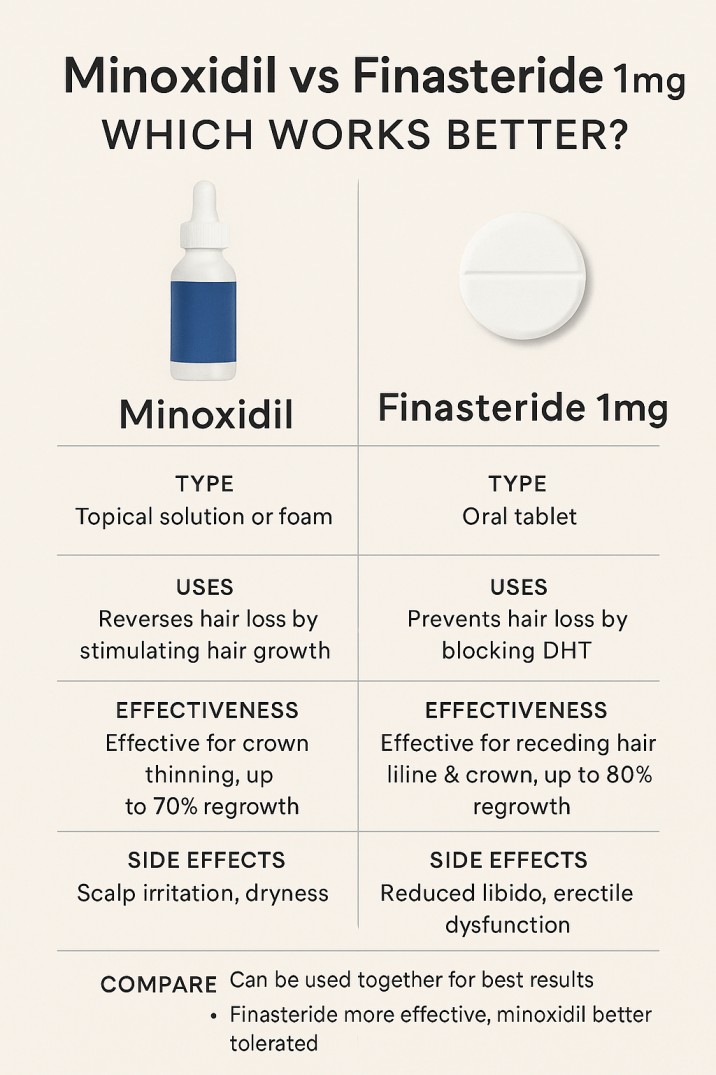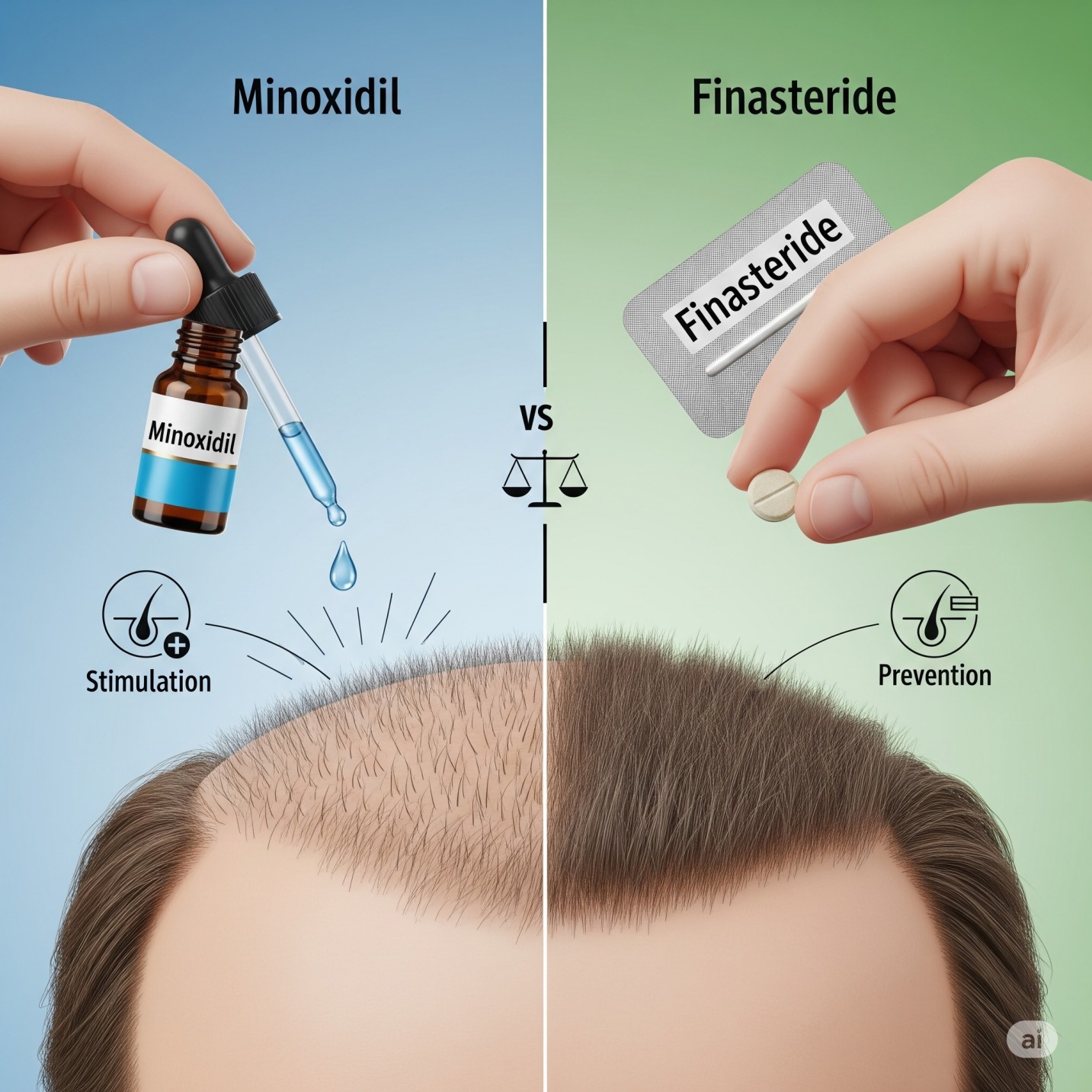Topical Minoxidil and Oral Finasteride 1mg are the only two pharmacological treatment options authorised for androgenetic alopecia. It’s quite hard to choose between them. Let’s find what’s better for you.
Staring at the mirror, noticing those receding hairlines or thinning patches can be heartbreaking. It is a salient struggle for many. The sinking feeling and silent sighs lead to desperate research for an effective solution that may provide permanent results. If you are one of those people who has lost a significant amount of hair, you’ve come to the right page. Get ready to reclaim your crowning glory. You are not alone in this journey. Well, it takes courage to seek solutions, and we hope this blog helps you in every way.
Two names often pop up when researching for a hair loss remedy, and these are Minoxidil and Finasteride, but are they effective? If so, how do you use them? And most importantly, which one is the best hair loss solution for you? Let’s dive into the facts that explain the differences, advantages and potential side effects of these clinically approved treatment options for hair loss.
Minoxidil and Finasteride: The Difference
Minoxidil and Finasteride are the two giants in the battle against hair loss. The goal of both treatments is to provide you with a thicker head of hair, but they differ in form, their mode of action, and potential benefits. Well, consider them as two different paths leading to the same destination, i.e., healthier hair growth. Whether you are a male experiencing the early signs of male pattern baldness or a female frustrated due to androgenetic alopecia, it is important to understand these differences. It helps you make an informed decision according to your unique hair health requirements.
What about Minoxidil?
Minoxidil solution is a topical hair loss therapy that is often supplied as a topical solution or foam. Originally discovered to treat hypertension (High blood pressure). Minoxidil’s hair growth-stimulating properties were an unexpected discovery. The topical medication works by enhancing the blood flow towards the hair follicles. The increase in the blood flow helps revitalise the dormant hairs, making them thicker and healthier. Whether you are using a Minoxidil liquid preparation or foam formulation, it offers a ray of hope to everyone who looks forward to a non-hormonal approach for effective hair loss therapy.
How does Minoxidil work?
For hair follicles that are rooted deep, thirsting for much-needed nourishment, Minoxidil is the answer, enhancing the blood flow to these hair follicles. Minoxidil is categorised under the class of medications known as Vasodilators that help widen blood vessels, ensuring a steady flow of essential components like oxygen and nutrients that reach each hair follicle. This causes rejuvenation of dormant hairs and extends the anagen (growth) phase. The results you achieve are longer and thicker hair.
What is Finasteride?
Finasteride 1mg is a prescription oral medication primarily used for men with male pattern hair loss. But what makes it different from any other hair loss medication? Well, it works on the hormone responsible for hair thinning, dihydrotestosterone (DHT). An excessive amount of DHT leads to hair thinning. Furthermore, by inhibiting the conversion of testosterone to DHT, Finasteride ceases the progression of hair loss and promotes the regrowth of hair. It gives hope to many who wish to feel teh presence of those long and thick waves once again. However, it is crucial to understand the mode of action as well as possible side effects before making it a part of your hair care regimen.
How does Finasteride work?
To keep your scalp healthy, you need the right environment, free from harmful elements. The entry of DHT (a byproduct of testosterone), which in excess can wreak havoc on the hair on your scalp, ultimately leading to male pattern baldness. Finasteride 1 mg inhibits the conversion of testosterone into DHT. Reduction in DHT levels protects your hair follicles and creates an environment supportive of hair growth, resulting in a significant enhancement in hair growth and density.
Possible side effects of Minoxidil and Finasteride
The major difference between Finasteride and Minoxidil lies in the side effects that a user may experience. No matter how promising the results are, almost all pharmaceutical ingredients can bring their own set of unwanted problems and concerns. But this information guide helps you through them.
For Minoxidil, the side effects are primarily localised. The commonly reported symptoms are itchiness, skin irritation, redness at the application site, and excessive hair growth on your body. This is not the complete list of side effects of Minoxidil. Some might experience severe reactions, like an irregular heartbeat and blurred vision.
On the other hand, oral Finasteride can affect the entire body as it gets absorbed into the system. The side effects include erectile dysfunction, decreased libido, breast enlargement and tenderness. While these side effects are rare, they can be more severe than those associated with Minoxidil solution. Your health is a priority. Therefore, it is always important to listen to your body and trust your feelings. If you get any of these symptoms, seek medical attention. Always remember your journey towards achieving the goal of a thicker head of hair; never compromise with your overall health.
Is it safe to use Finasteride and Minoxidil together?
So, can you combine the two powerful hair loss medications? Well, the answer backed by numerous research studies is a resounding yes. Both hair loss medicines with different modes of action can work together to offer a hair restoration solution. While taking both medications is generally safe, it is always a wise decision to consult a dermatologist who is an expert in treating hair loss problems. Keep a close eye on any unusual symptoms and seek a dermatologist’s advice before making any modifications to your hair loss treatment plan. After all, your journey is unique, and you deserve an individualistic approach.
What’s more effective?
Well, the answer is not straightforward. Finasteride offers a powerful solution for male pattern baldness by targeting the hormone responsible for hair thinning. Minoxidil focuses on enhancing blood flow and addressing various types of hair loss. Applied directly on the scalp, it promotes hair regrowth. Scientific studies suggest that both are effective in treating hair loss, but their suitability varies based on the type of hair loss and the individual’s hair loss. So, what’s the right option for you? Well, consult your dermatologist to get an individualised treatment plan that aligns with your unique hair health.
Getting on the path to restore your hair’s former glory. While both Finasteride and Minoxidil have proven their worth in the hair restoration arena, the right approach still depends on several factors. Firstly, you should consider the working mechanism. Finasteride works by blocking the hormones that affect hair growth, whereas Minoxidil works by improving blood circulation to revitalise hair follicles. Then, the matter of side effects should be discussed from skin irritation caused by Minoxidil to the stronger sexual effects some users experience with oral Finasteride. Moreover, Lifestyle preference should be considered, as the ease of popping a tablet versus directly applying the topical solution to the scalp comes into play. Last but not least, every individual’s response to the medication varies. Some might benefit from the monotherapy, while others might find the combination more fruitful.
The key is to consult a dermatologist and choose an option that supports your body’s requirements and hair aspirations.
Marie
Latest posts by Marie (see all)
- HCG 5000 IU Injection Online: Uses, Benefits, Dosage & Price - December 23, 2025
- What is an Antifungal Cream and How Does it Work? - December 19, 2025
- Life with Asthma: How the Right Inhaler Medicine can Change Everything? - December 15, 2025




